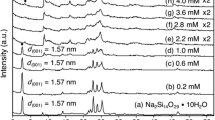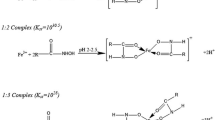Abstract
The purpose of this study was to determine the effects of pH, ion type (salt and metal cations), ionic strength, cation valence, hydrated ionic radius, and solid concentration on the zeta potential of kaolinite and quartz powder in the presence of NaCl, KCl, CaCl2, CuCl2, BaCl2, and AlCl3 solutions. The kaolinite and quartz powder have no isoelectric point (iep) within the entire pH range (3 < pH < 11). In the presence of hydrolysable metal ions, kaolinite and quartz powder have two ieps. As the cationic valence increases, the zeta potential of kaolinite and quartz powder becomes less negative. Monovalent cation, K+, yields more negative zeta potential values than the divalent cation Ba2+. As concentration of solid increases, the zeta potential of the minerals becomes more positive under acidic conditions; however, under alkaline conditions as solid concentration increases the zeta potential becomes more negative. Hydrated ionic radius also affects the zeta potential; the larger the ion, the thicker the layer and the more negative zeta potential for both kaolinite and quartz powder.










Similar content being viewed by others
References
Adamson AW, Gast AP (1997) Physical chemistry of surfaces. Wiley, New York
Alkan M, Demirbas O, Dogan M (2005) Electrokinetic properties of kaolinite in mono- and multivalent electrolyte solutions. Micropor Mesopor Mat 83:51–59
Besra L, Sengupta DK, Roy SK (2000) Particle characteristics and their influence on dewatering of kaolin, calcite and quartz suspensions. Int J Miner Process 59:89–112
Celik MS, Akin Y, Hancer M (1996) Decompression of electrical double layer with monovalent cations. Society of mining, metallurgy and exploration annual meeting, Phoneix, Arizona, 11–14 March
Chapman HD (1965) Cation exchange capacity. In: Black CA (ed) Methods of soil analysis, vol 9. American Institute of Agronomy, Madison, pp 891–901
Chorom M, Rengasamy P (1995) Dispersion and zeta potential of pure clays as related to net particle charge under varying pH, electrolyte concentration and cation type. Eur J Soil Sci 46:657–665
Dillard JG, Koppelman MH (1982) X-ray photoelectron spectroscopic (XPS) surface characterization of cobalt on the surface of kaolinite. J Coll Interface Sci 87:47–55
Ermakova TB, Sergeeva IP, Anuchkina AD, Sobolev VD, Churaev NV (2006) Electrokinetic study of layer-by-layer polyelectrolyte and surfactant adsorbed layers. Progr Colloid Polym Sci 132:95–101
Everett DH (1989) Basic principles of colloid science, 2nd edn. The Royal Society of Chemistry, London
Eykholt GR, Daniel DE (1994) Impact of system chemistry on electroosmosis in contaminated soil. J Geotech Eng 120:797–815
Fuerstenau DW, Jia R (2004) The adsorption of alkylpyridinium chlorides and their effect on the interfacial behavior of quartz. Coll Surf A Pyhsicochem Eng Asp 250:223–231
Huang P, Fuerstenau DW (2001) The effect of the adsorption of lead and cadmium ions on the interfacial behavior of quartz and talc. Coll Surf A Pyhsicochem Eng Asp 177:147–156
Hunter JR (1993) Introduction to modern colloid science. Oxford University Press, New York
James RO, Healy TW (1972) Adsorption of hydrolyzable metal ions at the oxide-water interface II. Charge reversal of SiO2 and TiO2 colloids by adsorbed Co(II), La(III), and Th(IV) as model systems. J Coll Interface Sci 40(1):53–64
Johnson PR (1999) A comparison of streaming and microelectrophoresis methods for obtaining the ζ potential of granular porous media surfaces. J Coll Interface Sci 209:264–267
Kaya A, Fang H-Y (1996) Characterization of dielectric constant on fine-grained soil behavior. In: Morgan JH (ed) Sampling environmental media. ASTM STP 1282
Kosmulski M, Dahlsten P (2006) High ionic strength electrokinetics of clay minerals. Coll Surf A Pyhsicochem Eng Asp 291:212
Kosmulski M, Maczka E, Janusz W, Rosenholm JB (2002) Multiinstrument study of the eletrophoretic mobility of quartz. J Coll Interface Sci 250:99
Larson I, Pugh RJ (1998) Coagulation of quartz particles in aqueous solutions of copper (II). Coll Interface Sci 208:399
Lorne B, Perrier F, Avouac J (1999) Streaming potential measurements 1. Properties of the electrical double layer from crushed rock samples. J Geophys Res 104:17.857
Ma KS, Pierre AC (1999) Clay sediment-structure formation in aqueous kaolinite suspensions. Clays Clay Miner 47:522
Mitchell JK (1993) Fundamentals of soil behavior, 2nd edn. Wiley, New York
Olphen HV (1963) Introduction to clay colloid chemistry. Wiley, New York
Prasanphan S, Nuntiya A (2006) Electrokinetic properties of kaolins, sodium feldspar and quartz. Chiang Mai J Sci 33(2):183–190
Rodriguez K, Araujo M (2006) Temperature and pressure effects on zeta potential values of reservoir materials. J Coll Interface Sci 300:788–794
Smith RW, Narimatsu Y (1993) Electrokinetic behavior of kaolinite in surfactant solutions as measured by both the microelectrophoresis and streaming potential methods. Miner Eng 6:753–763
Sparks DL (1986) Soil physical chemistry. CRC Press, Boca Raton
Sposito G (1989) Surface reactions in natural aqueous colloidal systems. Schweizerischer Chemiker Verband 43:169–176
Sridharan A (1991) Engineering behavior of fine-grained soils. Indian Geotech J 21(1):1–136
Vane LM, Zang GM (1997) Effect of aqueous phase properties on clay particle zeta potential and electro-osmotic permeability: implications for electro-kinetic soil remediation processes. J Hazard Mat 55:1–22
Virkutyte J, Sillanpää M, Latostenmaa P (2002) Electrokinetic soil remediation-critical overview. Sci Total Environ 289:97–121
West LJ, Stewart DL (2000) Effect of zeta potential on soil electrokinesis. Proceedings of Geoenvironment, ASCE, pp 1535–1549
Xu G, Zhang J, Song G (2003) Effect of complexation on the zeta potential of silica powder. Powder Technol 134:218–222
Yong RN, Warkentin BP (1966) Introduction to soil behavior. The Macmillan Company, Newyork
Yukselen Y, Kaya A (2003) Zeta potential of kaolinite in the presence of alkali, alkaline earth and hydrolyzable metal ions. Water Air Soil Pollut 145(1):155–168
Acknowledgments
Financial support was provided by the Scientific and Technical Research Council of Turkey, TUBITAK, (Grant No: INTAG 720) and Dokuz Eylul University Research Foundation (Grant No: 0908-99-01-03). Both funding are greatly appreciated. We wish to thank Prof. Dr. M. Sabri Çelik from Istanbul Technical University, for kindly allowing us to use his laboratory during the experimental program of the study.
Author information
Authors and Affiliations
Corresponding author
Rights and permissions
About this article
Cite this article
Yukselen-Aksoy, Y., Kaya, A. A study of factors affecting on the zeta potential of kaolinite and quartz powder. Environ Earth Sci 62, 697–705 (2011). https://doi.org/10.1007/s12665-010-0556-9
Received:
Accepted:
Published:
Issue Date:
DOI: https://doi.org/10.1007/s12665-010-0556-9




